Abstract
1,3-Butadiene, a high-production volume chemical used largely in the manufacture of synthetic rubber, is a multiple organ carcinogen in rats and mice. In inhalation studies conducted in mice by the National Toxicology Program, high rates of early lethal lymphomas occurring at exposure levels of 625 ppm or higher reduced the development and expression of later developing tumors at other sites. Use of survival-adjusted tumor rates to account for competing risk factors provided a clearer indication of the dose responses for 1,3-butadiene-induced neoplasms. An increase in lung tumors in female mice was observed at exposure concentrations as low as 6.25 ppm, the lowest concentration ever used in a long-term carcinogenicity study of this gas. Human exposures to 1,3-butadiene by workers employed at facilities that produce this chemical and at facilities that produce styrene-butadiene rubber have been measured at levels higher than those that cause cancer in animals. Furthermore, epidemiology studies have consistently revealed associations between occupational exposure to 1,3-butadiene and excess mortality due to lymphatic and hematopoietic cancers. In response to the carcinogenicity findings for 1,3-butadiene in animals and in humans, the Occupational Safety and Health Administration has proposed lowering the occupational exposure standard for this chemical from 1000 ppm to 2 ppm. Future work is needed to understand the mechanisms of tumor induction by 1,3-butadiene; however, the pursuit of this research should not delay the reduction of human exposure to this chemical.
Full text
PDF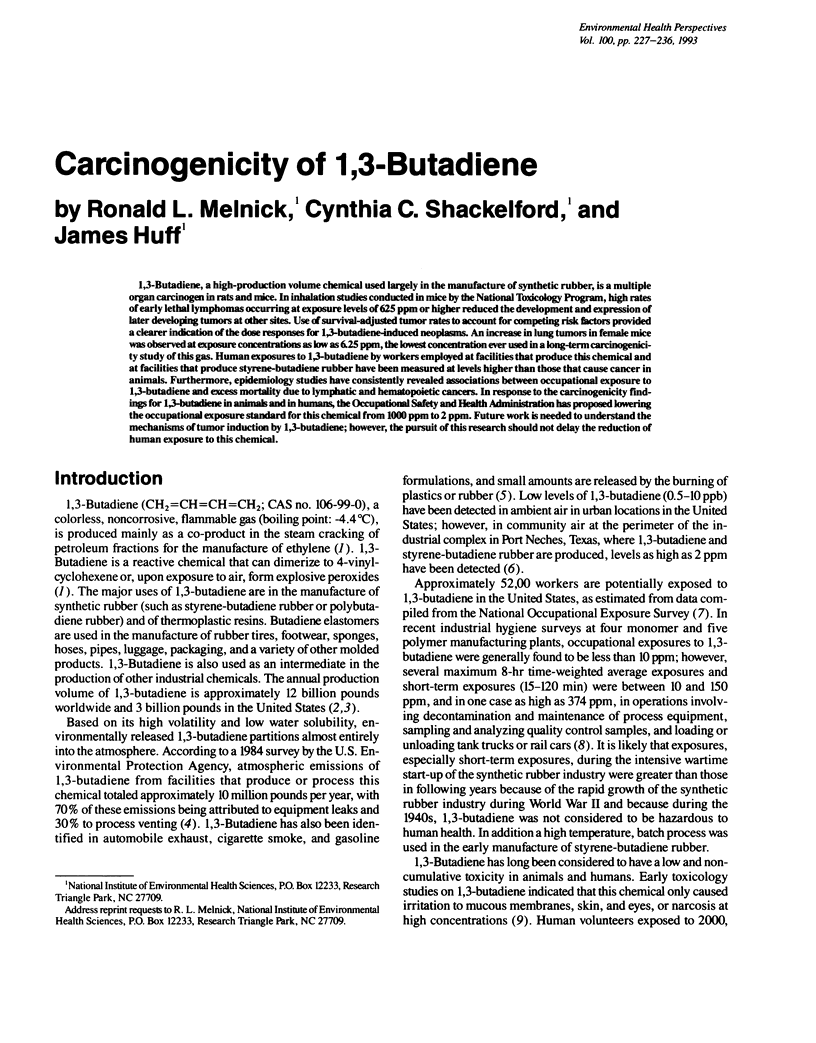
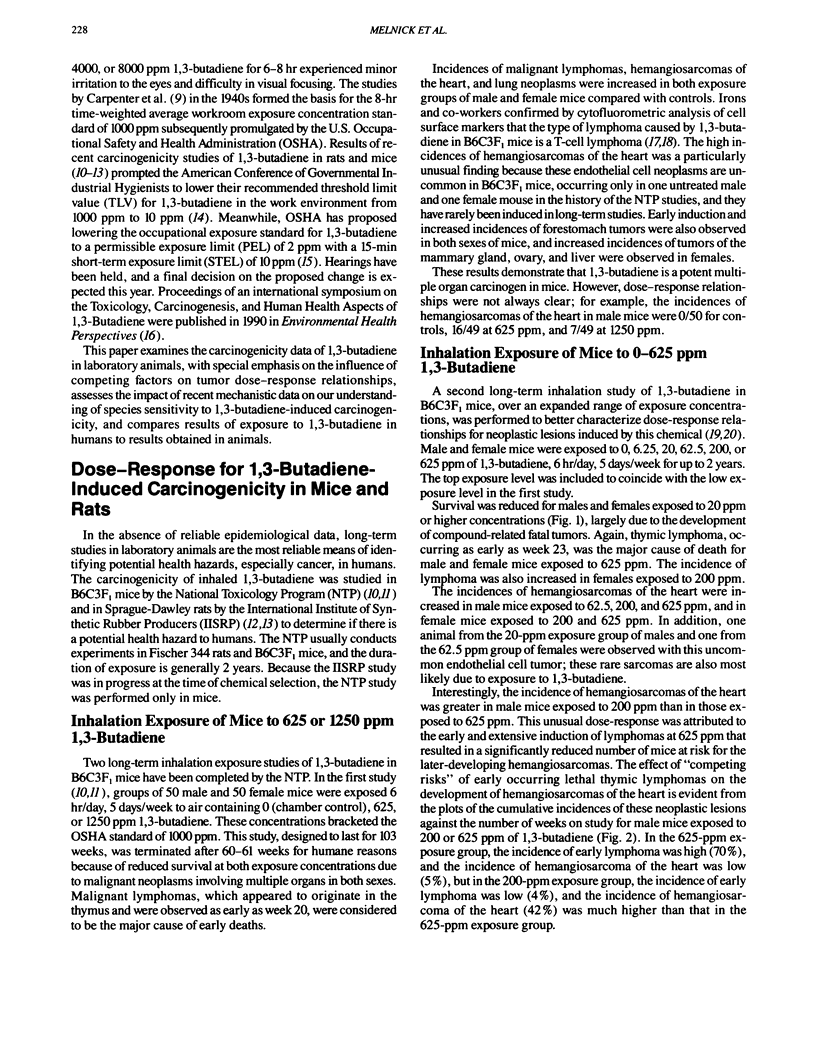
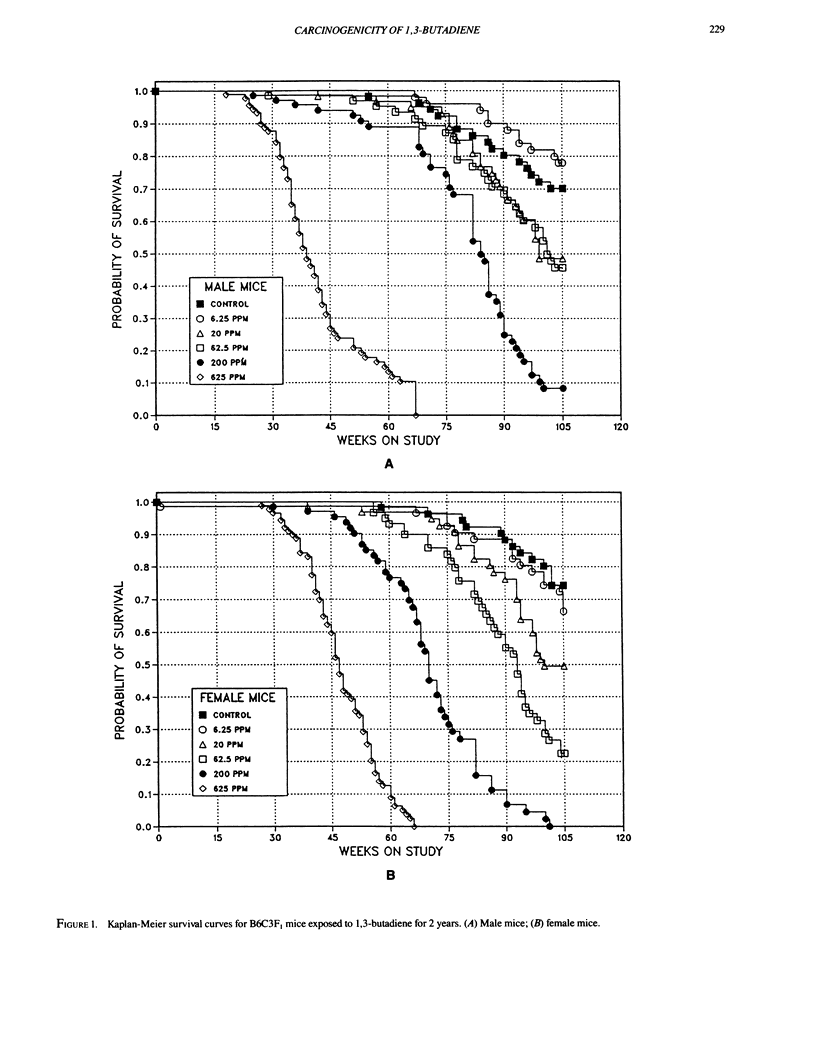

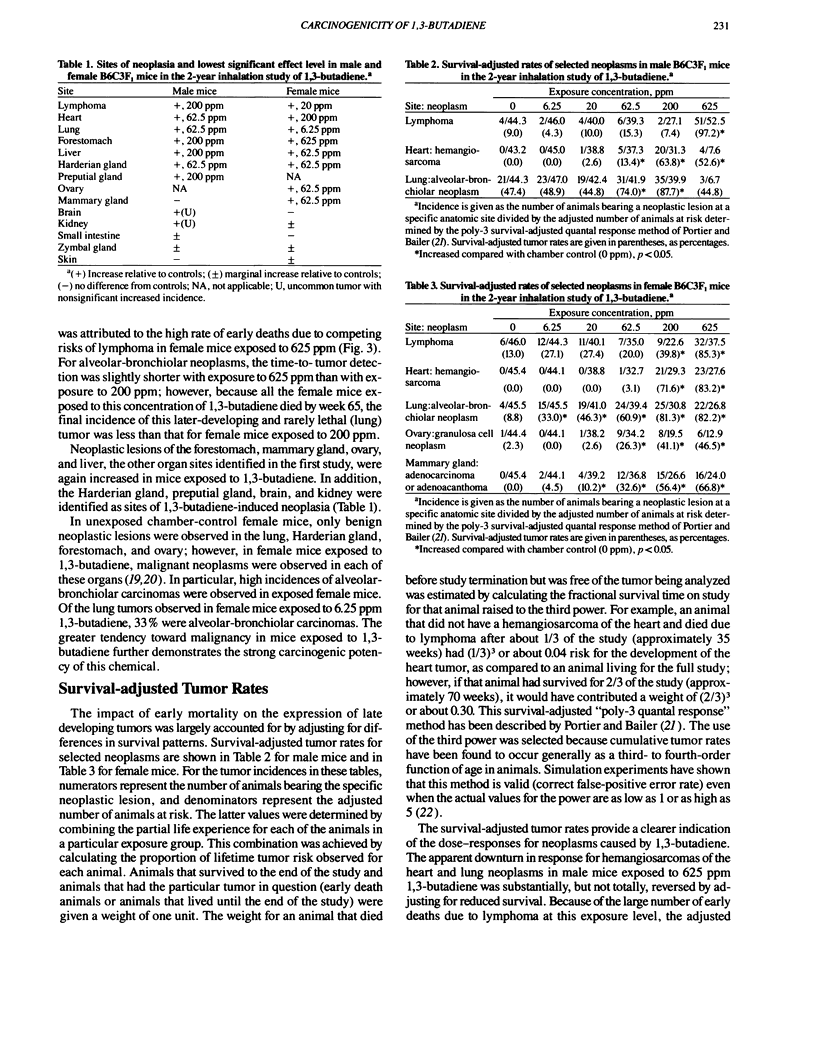
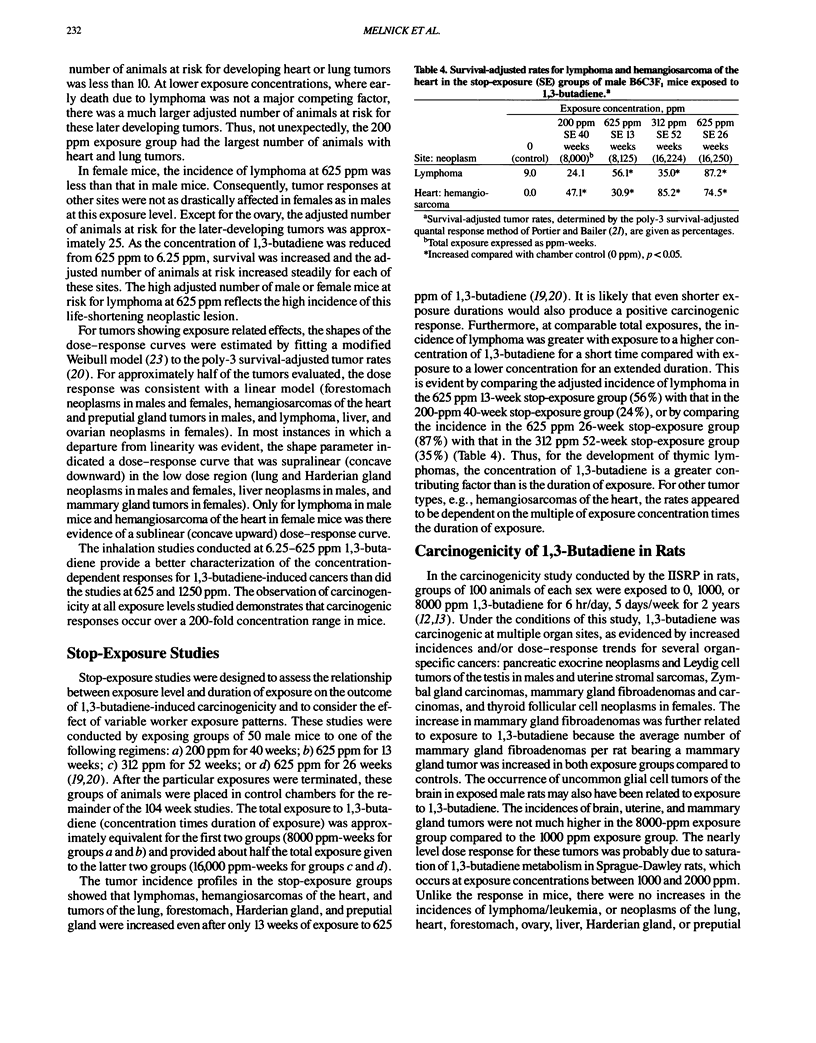
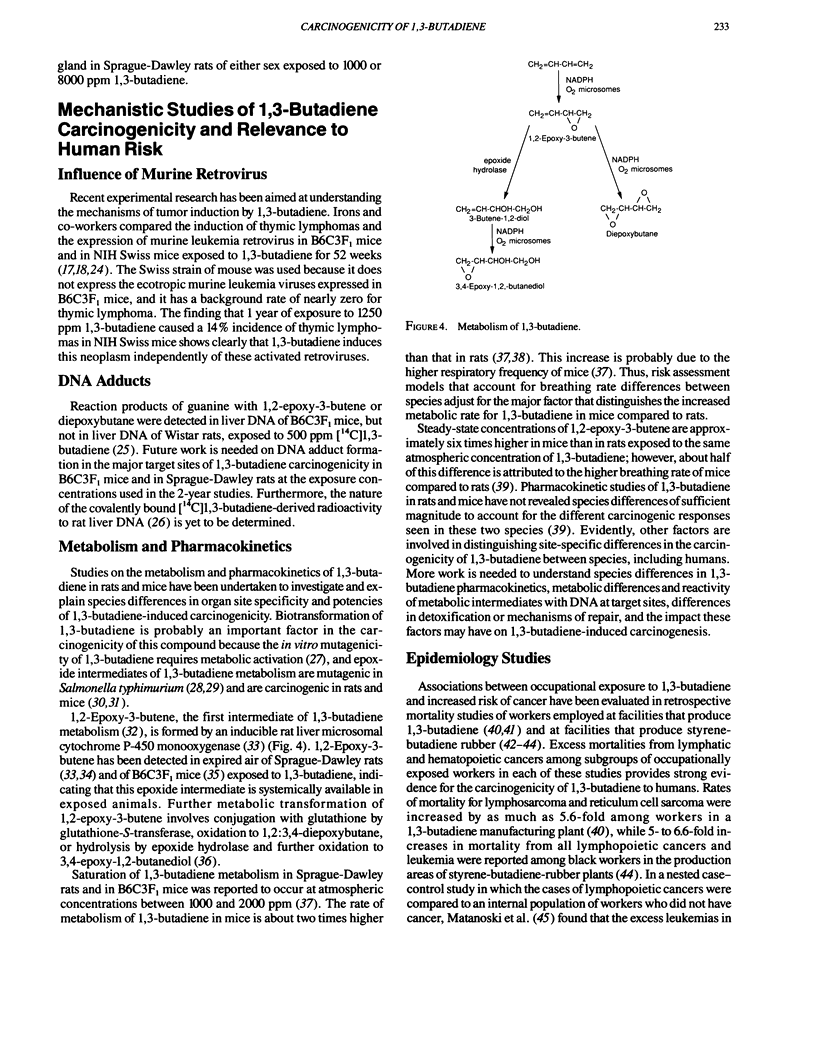
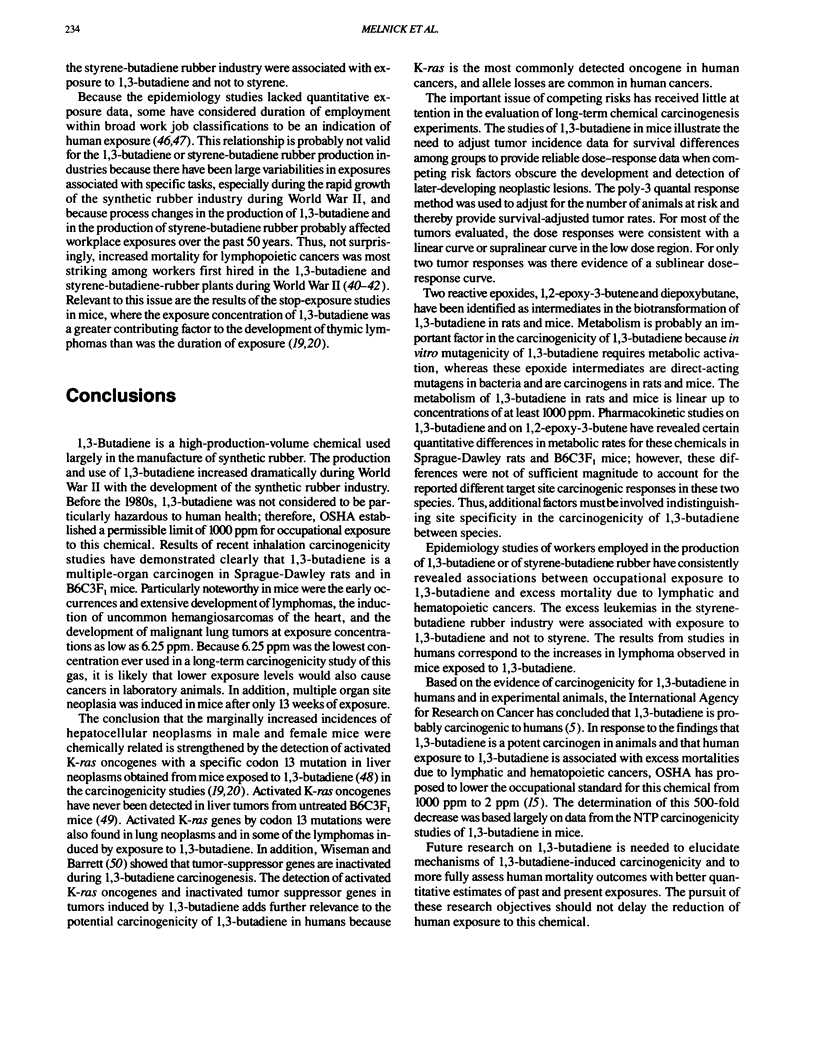
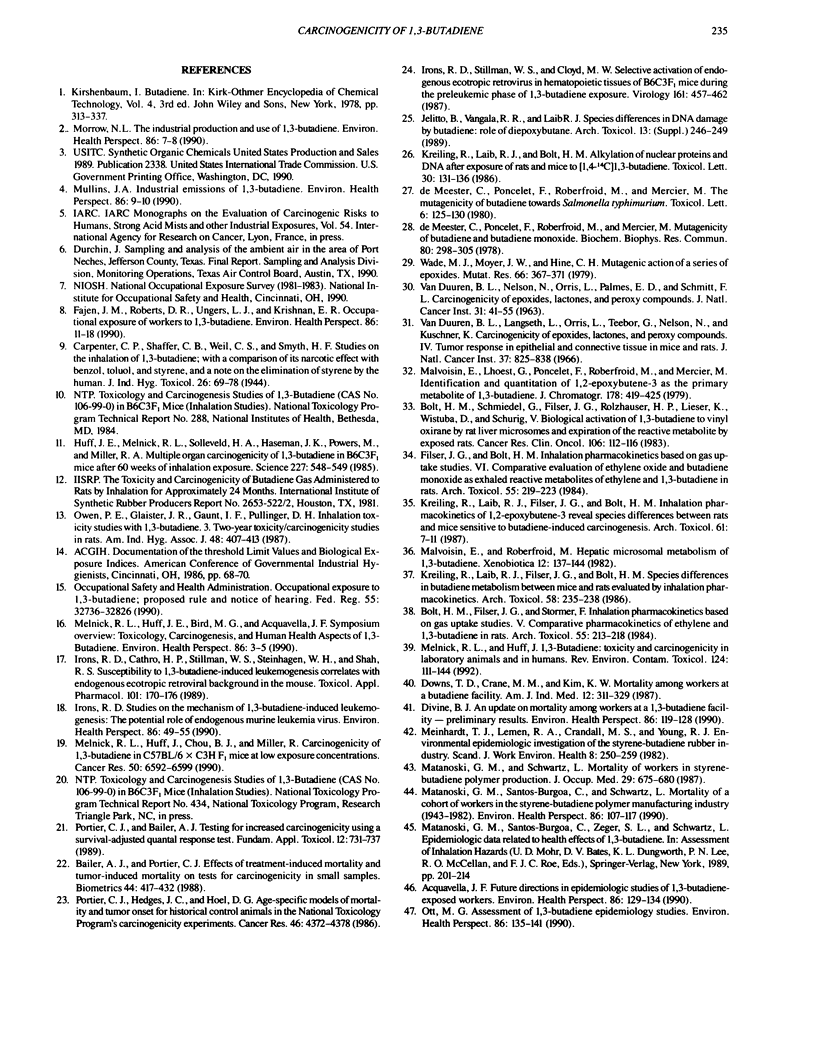

Selected References
These references are in PubMed. This may not be the complete list of references from this article.
- Acquavella J. F. Future directions in epidemiologic studies of 1,3-butadiene-exposed workers. Environ Health Perspect. 1990 Jun;86:129–134. doi: 10.1289/ehp.9086129. [DOI] [PMC free article] [PubMed] [Google Scholar]
- Bailer A. J., Portier C. J. Effects of treatment-induced mortality and tumor-induced mortality on tests for carcinogenicity in small samples. Biometrics. 1988 Jun;44(2):417–431. [PubMed] [Google Scholar]
- Bolt H. M., Filser J. G., Störmer F. Inhalation pharmacokinetics based on gas uptake studies. V. Comparative pharmacokinetics of ethylene and 1,3-butadiene in rats. Arch Toxicol. 1984 Oct;55(4):213–218. doi: 10.1007/BF00341013. [DOI] [PubMed] [Google Scholar]
- Bolt H. M., Schmiedel G., Filser J. G., Rolzhäuser H. P., Lieser K., Wistuba D., Schurig V. Biological activation of 1,3-butadiene to vinyl oxirane by rat liver microsomes and expiration of the reactive metabolite by exposed rats. J Cancer Res Clin Oncol. 1983;106(2):112–116. doi: 10.1007/BF00395388. [DOI] [PubMed] [Google Scholar]
- Divine B. J. An update on mortality among workers at a 1,3-butadiene facility--preliminary results. Environ Health Perspect. 1990 Jun;86:119–128. doi: 10.1289/ehp.9086119. [DOI] [PMC free article] [PubMed] [Google Scholar]
- Downs T. D., Crane M. M., Kim K. W. Mortality among workers at a butadiene facility. Am J Ind Med. 1987;12(3):311–329. doi: 10.1002/ajim.4700120307. [DOI] [PubMed] [Google Scholar]
- Fajen J. M., Roberts D. R., Ungers L. J., Krishnan E. R. Occupational exposure of workers to 1,3-butadiene. Environ Health Perspect. 1990 Jun;86:11–18. doi: 10.1289/ehp.908611. [DOI] [PMC free article] [PubMed] [Google Scholar]
- Filser J. G., Bolt H. M. Inhalation pharmacokinetics based on gas uptake studies. VI. Comparative evaluation of ethylene oxide and butadiene monoxide as exhaled reactive metabolites of ethylene and 1,3-butadiene in rats. Arch Toxicol. 1984 Oct;55(4):219–223. doi: 10.1007/BF00341014. [DOI] [PubMed] [Google Scholar]
- Goodrow T., Reynolds S., Maronpot R., Anderson M. Activation of K-ras by codon 13 mutations in C57BL/6 X C3H F1 mouse tumors induced by exposure to 1,3-butadiene. Cancer Res. 1990 Aug 1;50(15):4818–4823. [PubMed] [Google Scholar]
- Huff J. E., Melnick R. L., Solleveld H. A., Haseman J. K., Powers M., Miller R. A. Multiple organ carcinogenicity of 1,3-butadiene in B6C3F1 mice after 60 weeks of inhalation exposure. Science. 1985 Feb 1;227(4686):548–549. doi: 10.1126/science.3966163. [DOI] [PubMed] [Google Scholar]
- Irons R. D., Cathro H. P., Stillman W. S., Steinhagen W. H., Shah R. S. Susceptibility to 1,3-butadiene-induced leukemogenesis correlates with endogenous ecotropic retroviral background in the mouse. Toxicol Appl Pharmacol. 1989 Oct;101(1):170–176. doi: 10.1016/0041-008x(89)90222-6. [DOI] [PubMed] [Google Scholar]
- Irons R. D., Stillman W. S., Cloyd M. W. Selective activation of endogenous ecotropic retrovirus in hematopoietic tissues of B6C3F1 mice during the preleukemic phase of 1,3-butadiene exposure. Virology. 1987 Dec;161(2):457–462. doi: 10.1016/0042-6822(87)90139-5. [DOI] [PubMed] [Google Scholar]
- Irons R. D. Studies on the mechanism of 1,3-butadiene-induced leukemogenesis: the potential role of endogenous murine leukemia virus. Environ Health Perspect. 1990 Jun;86:49–55. doi: 10.1289/ehp.908649. [DOI] [PMC free article] [PubMed] [Google Scholar]
- Jelitto B., Vangala R. R., Laib R. J. Species differences in DNA damage by butadiene: role of diepoxybutane. Arch Toxicol Suppl. 1989;13:246–249. doi: 10.1007/978-3-642-74117-3_42. [DOI] [PubMed] [Google Scholar]
- Kreiling R., Laib R. J., Bolt H. M. Alkylation of nuclear proteins and DNA after exposure of rats and mice to [1,4-14C]1,3-butadiene. Toxicol Lett. 1986 Feb;30(2):131–136. doi: 10.1016/0378-4274(86)90095-0. [DOI] [PubMed] [Google Scholar]
- Kreiling R., Laib R. J., Filser J. G., Bolt H. M. Inhalation pharmacokinetics of 1,2-epoxybutene-3 reveal species differences between rats and mice sensitive to butadiene-induced carcinogenesis. Arch Toxicol. 1987;61(1):7–11. doi: 10.1007/BF00324541. [DOI] [PubMed] [Google Scholar]
- Kreiling R., Laib R. J., Filser J. G., Bolt H. M. Species differences in butadiene metabolism between mice and rats evaluated by inhalation pharmacokinetics. Arch Toxicol. 1986 Apr;58(4):235–238. doi: 10.1007/BF00297112. [DOI] [PubMed] [Google Scholar]
- Malvoisin E., Roberfroid M. Hepatic microsomal metabolism of 1,3-butadiene. Xenobiotica. 1982 Feb;12(2):137–144. doi: 10.3109/00498258209046787. [DOI] [PubMed] [Google Scholar]
- Matanoski G. M., Santos-Burgoa C., Schwartz L. Mortality of a cohort of workers in the styrene-butadiene polymer manufacturing industry (1943-1982). Environ Health Perspect. 1990 Jun;86:107–117. doi: 10.1289/ehp.9086107. [DOI] [PMC free article] [PubMed] [Google Scholar]
- Matanoski G. M., Schwartz L. Mortality of workers in styrene-butadiene polymer production. J Occup Med. 1987 Aug;29(8):675–680. [PubMed] [Google Scholar]
- Meinhardt T. J., Lemen R. A., Crandall M. S., Young R. J. Environmental epidemiologic investigation of the styrene-butadiene rubber industry. Mortality patterns with discussion of the hematopoietic and lymphatic malignancies. Scand J Work Environ Health. 1982 Dec;8(4):250–259. doi: 10.5271/sjweh.2469. [DOI] [PubMed] [Google Scholar]
- Melnick R. L., Huff J. 1,3-Butadiene: toxicity and carcinogenicity in laboratory animals and in humans. Rev Environ Contam Toxicol. 1992;124:111–144. doi: 10.1007/978-1-4612-2864-6_5. [DOI] [PubMed] [Google Scholar]
- Melnick R. L., Huff J., Chou B. J., Miller R. A. Carcinogenicity of 1,3-butadiene in C57BL/6 x C3H F1 mice at low exposure concentrations. Cancer Res. 1990 Oct 15;50(20):6592–6599. [PubMed] [Google Scholar]
- Mullins J. A. Industrial emissions of 1,3-butadiene. Environ Health Perspect. 1990 Jun;86:9–10. doi: 10.1289/ehp.90869. [DOI] [PMC free article] [PubMed] [Google Scholar]
- Ott M. G. Assessment of 1,3-butadiene epidemiology studies. Environ Health Perspect. 1990 Jun;86:135–141. doi: 10.1289/ehp.9086135. [DOI] [PMC free article] [PubMed] [Google Scholar]
- Owen P. E., Glaister J. R., Gaunt I. F., Pullinger D. H. Inhalation toxicity studies with 1,3-butadiene. 3. Two year toxicity/carcinogenicity study in rats. Am Ind Hyg Assoc J. 1987 May;48(5):407–413. doi: 10.1080/15298668791384959. [DOI] [PubMed] [Google Scholar]
- Portier C. J., Bailer A. J. Testing for increased carcinogenicity using a survival-adjusted quantal response test. Fundam Appl Toxicol. 1989 May;12(4):731–737. doi: 10.1016/0272-0590(89)90004-3. [DOI] [PubMed] [Google Scholar]
- Portier C. J., Hedges J. C., Hoel D. G. Age-specific models of mortality and tumor onset for historical control animals in the National Toxicology Program's carcinogenicity experiments. Cancer Res. 1986 Sep;46(9):4372–4378. [PubMed] [Google Scholar]
- Reynolds S. H., Stowers S. J., Patterson R. M., Maronpot R. R., Aaronson S. A., Anderson M. W. Activated oncogenes in B6C3F1 mouse liver tumors: implications for risk assessment. Science. 1987 Sep 11;237(4820):1309–1316. doi: 10.1126/science.3629242. [DOI] [PubMed] [Google Scholar]
- VANDUUREN B. L., NELSON N., ORRIS L., PALMES E. D., SCHMITT F. L. CARCINOGENICITY OF EPOXIDES, LACTONES, AND PEROXY COMPOUNDS. J Natl Cancer Inst. 1963 Jul;31:41–55. [PubMed] [Google Scholar]
- Van Duuren B. L., Langseth L., Orris L., Teebor G., Nelson N., Kuschner M. Carcinogenicity of epoxides, lactones, and peroxy compounds. IV. Tumor response in epithelial and connective tissue in mice and rats. J Natl Cancer Inst. 1966 Dec;37(6):825–838. [PubMed] [Google Scholar]
- Wade M. J., Moyer J. W., Hine C. H. Mutagenic action of a series of epoxides. Mutat Res. 1979 Apr;66(4):367–371. doi: 10.1016/0165-1218(79)90047-8. [DOI] [PubMed] [Google Scholar]
- de Meester C., Poncelet F., Roberfroid M., Mercier M. Mutagenicity of butadiene and butadiene monoxide. Biochem Biophys Res Commun. 1978 Jan 30;80(2):298–305. doi: 10.1016/0006-291x(78)90676-9. [DOI] [PubMed] [Google Scholar]
- de Meester C., Poncelet F., Roberfroid M., Mercier M. The mutagenicity of butadiene towards Salmonella typhimurium. Toxicol Lett. 1980 Aug;6(3):125–130. doi: 10.1016/0378-4274(80)90179-4. [DOI] [PubMed] [Google Scholar]


